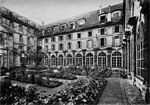Church of Saint-Ignace, Paris

The Church of Saint-Ignace is a large Roman Catholic chapel located at 33 Rue de Sèvres in the 6th arrondissement of Paris. Is is dedicated to Saint Ignace de Loyola, founder of Companions of Jesus, or Jesuits. The church was built between 1855 and 1858, following the plans of the Jesuit father and architect Magloire Tournesac (1805–1875). It is built in the Neo-Gothic style. Though it is not formally a parish church, the jesuit fathers carry out the liturgical and pastoral duties. The church is also connected with the Centre Sèvres, the faculty of philosophy and theology for the Jesuits of Paris. Some of the art in the church depicts the martyrdom of Jesuit missionaries in Japan in the 1860s.
Excerpt from the Wikipedia article Church of Saint-Ignace, Paris (License: CC BY-SA 3.0, Authors, Images).Church of Saint-Ignace, Paris
Rue de Sèvres, Paris 7th Arrondissement (Paris)
Geographical coordinates (GPS) Address External links Nearby Places Show on map
Geographical coordinates (GPS)
| Latitude | Longitude |
|---|---|
| N 48.85064 ° | E 2.32629 ° |
Address
Église Saint-Ignace
Rue de Sèvres
75007 Paris, 7th Arrondissement (Paris)
Ile-de-France, France
Open on Google Maps







